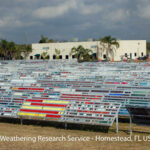
The annual faculty workshop is one of the most exciting programs produced by the Metal Building Manufacturers Association (MBMA). Each year, we bring together academics from across America for an action-packed program that makes the concept of metal buildings come alive.
“Our faculty workshop is the only outreach program of its kind in our industry,” says MBMA general manager Tony Bouquot. “We’re very proud of its popularity and success.”
The program was developed as an annual multi-day faculty workshop to educate professors about metal buildings, so they have the knowledge and materials to use in the classroom to influence and inspire the next generation of architects, engineers, and design students.
MBMA’s 2025 program was presented in partnership with the University of Houston’s Gerald D. Hines College of Architecture and Design. Having elements of the event directly on a university campus really excited the attendees. All attendees appreciated seeing where other professors teach and what tools they bring to the classroom.
The first half of the first day of the workshop was devoted to presentations about metal building technology provided by professors and practitioners alike. The energy was palpable as the attendees absorbed the information. “In fact, with almost every presentation, we had to limit the Q&A sessions because the attendees had so many questions,” says John Underwood, chair of the MBMA education committee, who has been helping facilitate the faculty workshops since they began six years ago. “Attendees were just so enthused.”
The afternoon session began at the University of Houston with tours of Keeland Lab and the Gerald D. Hines College of Architecture. Attendees viewed an exhibition dealing with the issue of housing and the need to examine its definition in light of the climate, economic, and social changes that are reshaping our perception of shelter in general and single-family homes in particular. Each of the 12 models was unique, and workshop participants described the options as “very creative” and “out there.”
Then, attendees went to Rice University to tour the William T. Cannady Hall for Architecture, a 2,044 m2 (22,000 sf) addition to the Rice School of Architecture. Located along the university’s historic quadrangle, the building is designed to foster architectural production, research, and exhibition. The workshop attendees were treated to a walking tour of the Rice campus with stops at several unique buildings, including Brochstein Pavilion and Turrell Skyspace.
Next, the group ventured to the construction site of the new Susan and Fayez Sarofim Hall, where they enjoyed a hardhat tour of all four floors. This 7,711 m2 (83,000 sf) building is slated to open in the fall and will serve as a central hub for the university’s arts program.
The architect released a stunning statement about the building, which is not metal but pays homage to a popular metal building it replaces. Sarofim Hall will be a new home for the visual arts at Rice University, acting as a gateway into campus and a hub for cross-disciplinary practice. The form recalls the much-loved but now obsolete tin house Art Barn and Media Center that occupied the site from the late 60s until recently.
But wait! There’s more!

The faculty workshop ended on a high note the following day when attendees were treated to a comprehensive tour of a metal building manufacturing facility. This tour is a staple activity each year as it is recognized as a true highlight of the workshop by attendees. MBMA member Cornerstone Building Brands hosted the tour at their Houston plant, demonstrating to attendees how metal buildings have entered the 21st century with high-tech, computer-controlled
manufacturing equipment and processes. Attendees were impressed with the material optimization built into the metal building manufacturing process, leading to minimal scrap and a greener building product.
Below are a mix of thoughts and reactions from faculty members participating in MBMA’s 2025 Faculty Workshop.
- Marcel Eminy, professor of the practice, Texas A&M University, says, “The MBMA Faculty Workshop in Houston was especially valuable for its hands-on learning opportunities and direct engagement with both industry professionals and fellow educators. Highlights included insightful presentations on integrating metal building systems into curricula, tours of innovative projects at the University of Houston and Rice University, and a visit to a metal building manufacturing plant to see modern construction processes firsthand. The workshop also provided useful resources and strategies for incorporating the MBMA Student Design Competition into coursework. Overall, it was an informative experience that enhanced understanding of metal building systems in architectural education.”
- Amar Sawhney, professor of architecture, Miami-Dade College, says, “The field trips were a great learning experience, and I will use the workshop information in my class projects.”
- Mark Roddy, FAIA, lecturer, Department of Design, California State University, Sacramento, notes, “The most interesting aspect of the workshop was the fabrication facility tour of Cornerstone Building Brands. We were able to see the process of how all the components are fabricated and integrated to be shipped to the customer. The coupling of design and fabrication using technology, including robotic welders, was fascinating.”
- Awilda Rodriguez Carrion, RA, associate professor of architecture, Christopher C. Gibbs College of Architecture, University of Oklahoma, says, “As a faculty member in architecture with over 20 years of experience, attending the MBMA Faculty Workshop has opened my eyes to a wealth of educational resources; particularly design guidelines and case studies … integrating these resources into my pedagogy can significantly enhance students’ design literacy and inspire more informed, forward-thinking architectural solutions.”
- Grant Mosey, assistant professor of architecture, University of Nevada, Las Vegas, says, “I think the most interesting part for me is learning new use cases for this building type. The tendency is to see these buildings as part of a utilitarian, vernacular architecture, so it’s always fascinating to see what unique solutions can come from the same kit of parts and what they can become with a little imagination. The material economy of these buildings, their long spans, and their quick field construction timeline make them attractive for uses far beyond the agricultural and light industrial programs with which they have historically been most closely associated.”
- Gregory A. Luhan, Ph.D., FAIA, The Ward V. Wells endowed professor of architecture, department head of Architecture College, Texas A&M University, says, “The valuable insights gained from the MBMA Faculty Workshop in Houston catalyzed groundbreaking collaborations between educators and the MBMA. Together, academia and industry partners can develop an array of innovative resources that elevate the visibility of metal buildings, pinpoint areas of cutting-edge advancements, advocate for technological solutions, and enhance educational avenues for students, faculty, and industry professionals across various settings, transcending the confines of the traditional classroom and design studio.”
- Paolo Sanza, RA, associate professor of architecture, Christopher C. Gibbs College of Architecture, University of Oklahoma, says, “Touring built and under construction projects and steel fabrication sites provided a valuable and highly educational experience and offered insights on incorporating new (design) strategies in the studio environment. Furthermore, the format of the workshop facilitated dialogue among faculty from different institutions and provided great opportunities for networking and future collaborations.”
MBMA holds its faculty workshop each spring in locations around the country. The 2026 workshop is tentatively scheduled at the University of Massachusetts Amherst. For more information, contact mbma@mbma.com.
Christen Funk is president of Butler Manufacturing, a founding Metal Building Manufacturers Association (MBMA) member company, and chair of MBMA’s board of directors.






